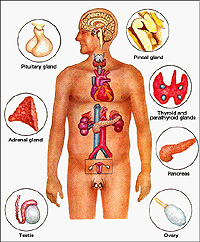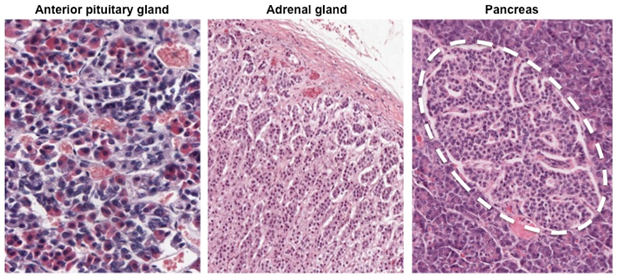 The
organs grouped together as the endocrine system represent many
structures with a great deal of morphological and functional
diversity. They are grouped together because their secretions are
carried to target tissues and organs primarily by the blood stream,
rather than by ducts as occurs in exocrine glands. Endocrine glands
may be large, distinct organs (e.g. pituitary and adrenal glands),
scattered groups of cells (e.g. pancreatic islets), or individual
cells (e.g. mucosa of digestive system). A structural feature common
to all endocrine tissues is a very rich vascular supply.
Furthermore, in spite of having origins from diverse kinds of
tissues, almost all endocrine glands are structurally epithelioid
(see images below), meaning they are composed of sheets, tubes,
columns, or clusters of closely contiguous cells. In contrast to
exocrine glands where secretory granules are readily visible, the
visible presence of secretory granules is less common in endocrine
glands. The
organs grouped together as the endocrine system represent many
structures with a great deal of morphological and functional
diversity. They are grouped together because their secretions are
carried to target tissues and organs primarily by the blood stream,
rather than by ducts as occurs in exocrine glands. Endocrine glands
may be large, distinct organs (e.g. pituitary and adrenal glands),
scattered groups of cells (e.g. pancreatic islets), or individual
cells (e.g. mucosa of digestive system). A structural feature common
to all endocrine tissues is a very rich vascular supply.
Furthermore, in spite of having origins from diverse kinds of
tissues, almost all endocrine glands are structurally epithelioid
(see images below), meaning they are composed of sheets, tubes,
columns, or clusters of closely contiguous cells. In contrast to
exocrine glands where secretory granules are readily visible, the
visible presence of secretory granules is less common in endocrine
glands.

The learning objectives for this
unit are:
- Identify the adenohypophysis
(anterior pituitary) and neurohypophysis (posterior pituitary
gland) and their unique cellular organization.
- Identify the cortex and medulla
of the adrenal gland and their associated cell types.
- Identify thyroid follicles,
colloid, and parafollicular cells in the thyroid gland.
- Identify parathyroid tissue and
its chief and oxyphil cells.
- Recognize the structure of the
pineal gland and explain its variability.
Pituitary gland |